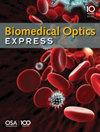Reducing manual labeling requirements and improved retinal ganglion cell identification in 3D AO-OCT volumes using semi-supervised learning
IF 2.9
2区 医学
Q2 BIOCHEMICAL RESEARCH METHODS
引用次数: 0
Abstract
Adaptive optics-optical coherence tomography (AO-OCT) allows for the three-dimensional visualization of retinal ganglion cells (RGCs) in the living human eye. Quantitative analyses of RGCs have significant potential for improving the diagnosis and monitoring of diseases such as glaucoma. Recent advances in machine learning (ML) have made possible the automatic identification and analysis of RGCs within the complex three-dimensional retinal volumes obtained with such imaging. However, the current state-of-the-art ML approach relies on fully supervised training, which demands large amounts of training labels. Each volume requires many hours of expert manual annotation. Here, two semi-supervised training schemes are introduced, (i) cross-consistency training and (ii) cross pseudo supervision that utilize unlabeled AO-OCT volumes together with a minimal set of labels, vastly reducing the labeling demands. Moreover, these methods outperformed their fully supervised counterpart and achieved accuracy comparable to that of human experts.利用半监督学习减少人工标记要求并改进三维 AO-OCT 图像中视网膜神经节细胞的识别
自适应光学-光学相干断层扫描(AO-OCT)可实现活体人眼视网膜神经节细胞(RGC)的三维可视化。对 RGCs 的定量分析在改善青光眼等疾病的诊断和监测方面具有巨大潜力。机器学习(ML)的最新进展使得在这种成像技术获得的复杂三维视网膜体积中自动识别和分析 RGC 成为可能。然而,目前最先进的 ML 方法依赖于完全监督训练,这需要大量的训练标签。每个体积都需要专家人工标注许多小时。本文介绍了两种半监督训练方案:(i) 交叉一致性训练和 (ii) 交叉伪监督,它们利用未标记的 AO-OCT 容量和最小标签集,大大降低了标记需求。此外,这些方法的效果优于完全监督的方法,其准确度可与人类专家相媲美。
本文章由计算机程序翻译,如有差异,请以英文原文为准。
求助全文
约1分钟内获得全文
求助全文
来源期刊

Biomedical optics express
BIOCHEMICAL RESEARCH METHODS-OPTICS
CiteScore
6.80
自引率
11.80%
发文量
633
审稿时长
1 months
期刊介绍:
The journal''s scope encompasses fundamental research, technology development, biomedical studies and clinical applications. BOEx focuses on the leading edge topics in the field, including:
Tissue optics and spectroscopy
Novel microscopies
Optical coherence tomography
Diffuse and fluorescence tomography
Photoacoustic and multimodal imaging
Molecular imaging and therapies
Nanophotonic biosensing
Optical biophysics/photobiology
Microfluidic optical devices
Vision research.
 求助内容:
求助内容: 应助结果提醒方式:
应助结果提醒方式:


